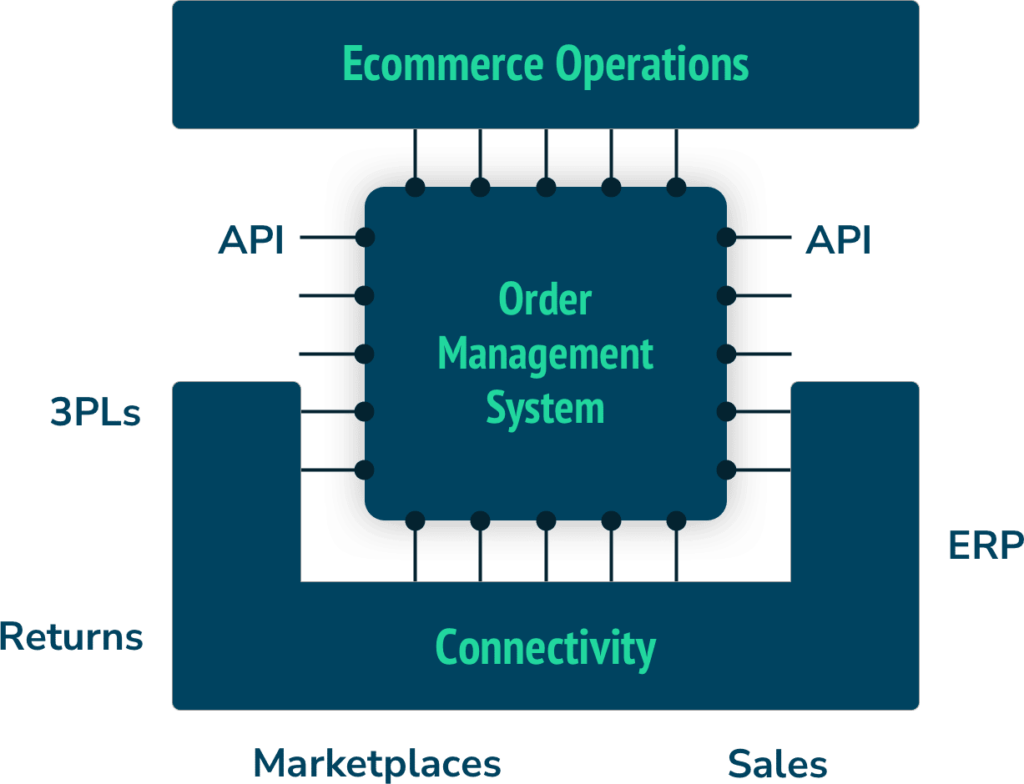From a post-checkout, order-to-fulfillment perspective, the current state of the e-commerce industry can be described as “hyper fragmented”. At the core there is a connectivity problem. The post-checkout ecosystem consists of 1000s of platform providers that can broadly be categorized into:
- Selling Channels (shopping carts, marketplaces and points of sale systems)
- Fulfillment Channels (3PLs, Warehouse Management Systems/WMS and Returns providers)
- Systems of Record (ERPs, inventory management and financial systems)
Having a continual exchange of data between providers is an essential part of nearly every post-checkout solution, because at a high-level merchants are operating a complex set of workflows that stretch across these categories. The two most frequent post-checkout operational challenges that merchants encounter are:
- Ensuring order processing and inventory updates are working in lockstep, otherwise overselling, fulfillment errors and other problems can occur
- Significant service switching and churn, especially with 3rd Party Logistics (3PL) providers, which requires integrating new providers into an always running ecosystem
Compounding the problem further is the fact that merchants’ technical acumen varies wildly. While some brands and merchants have in-house developers or trusted technology partners, many – including some surprisingly large ones – do not.
What is composable commerce?
For the less technical, or those that prefer to focus their developers on other things, “composable commerce” refers to an approach to ecommerce solution development whereby merchants weave together best-of-breed applications and/or components into a seamless e-commerce solution. Advantages of using a composable commerce approach include:
- Leverage best of breed components that more closely align with needs
- Greater agility and improved speed to market
- Flexibility to build out customized experiences
- Avoiding vendor lock-in
Bringing headless platforms and composable commerce into this chaotic post-checkout world can be quite challenging. Given the requirements, custom built API to API solutions and even integration platforms are impractical. Ideally merchants need the ability to extend their composable solution into post-checkout so that it matches the tempo of the business. This is where Pipe17 comes in.
As it relates to the post-checkout, order-to-fulfillment tier, a composable approach requires three components.
1) Simple, low latency connectivity and data synchronization
Orders, fulfillments, products and inventory data must be kept in sync across multiple selling and fulfillment channels, order and inventory management systems, ERPs, etc.
2) Centralized, canonical cross-application mapping and workflows
Because each application has its own definition of orders, products, fulfillments etc, providing a centralized mechanism for translating between applications (called a “canonical format”) speeds up integration work dramatically, and supports “plug and play” connectivity. As system complexity grows, this approach can be 10X faster than point-to-point approaches. In addition, businesses also need the ability to route orders, refresh inventory across channels and deal with format mismatches between applications (SKUs, products/bundles etc) depending on a range of business needs.
3) Endpoint monitoring and notification
Given the number of steps and applications involved in getting an order through to fulfillment, robust monitoring is essential. At any point along their journey, orders can get stuck for any number of reasons.
MACH Alliance
To tackle these requirements, we at Pipe17 are aligned with the MACH Alliance key principles that contribute to a more modern and manageable merchant experience.
Microservices – a technical term, but at its core it means that merchants have the ability to pick and choose “best of breed” ecommerce functionality (aka “microservices”) and assemble them into a unified commerce experience. This is in contrast to the traditional, single platform approach that aims to provide the entire range of services a merchant requires, binding the merchant to the vendor in perpetuity with services that are often lacking in quality and functionality. With Pipe17 merchants can easily choose – and change – service providers and systems of record for Product Catalog, Inventory, Order Routing, etc.
API-first approaches enable functionality to be accessed through an API as a system level connection, in addition to a user interface. For Pipe17, this means two things: First, anything that is possible in our UI can also be done via our API, enabling partners and more technical merchants to automate even more functionality and provide different user experiences on top of our platform. Second, 3rd parties can develop their own connectors to Pipe17, which are then able to connect to any other system in the Pipe17 network. This “hub and spoke” model makes it possible for businesses to use Pipe17 in a “one API to rule them all” style. A single connector to Pipe17 can enable access to dozens of selling platforms, marketplaces and ERPs and thousands of 3PLs / fulfillment providers.
Cloud native SaaS is in our DNA, we give merchants the ability to compose and run their post-checkout solution as a service from the cloud. Running natively on Amazon Web Services means that Pipe17 can handle virtually unlimited volumes of transactions, scaling up and down as needed. Providing a “multi-tenant” architecture means that all our customers get immediate access to new features as soon as they are available and there is no need to worry about versions or upgrades. As an operational concept, it also means that Pipe17 can centrally operate and manage all the components that make up our product offering (see microservices, above), reducing operational costs for our merchants and partners.
Headless means that the front-end user interface, including the catalog and shopping cart, are logically separated from the back-end systems. This allows different internal users to get the benefits of the tools most familiar to them – financial personnel can live in the ERP system, business leaders can work within the selling channels and marketplaces and operational team members can see a real-time, unified view of their transactions flowing through their Pipe17 “Order Cloud”.

Pipe17 provides an alternative to the costly waves of rip-and-replace cycles that interrupt businesses for months or even years. The old way is to start with point-to-point connectivity solutions; then replace these with order and inventory management systems; then replace these with an ERP. Pipe17’s architecture enables merchants to evolve at the speed of their business, and not be constrained by the speed or capabilities of a single vendor.
Enough technical – what’s in it for me?
The principles which enable Composable Commerce are technical and architectural, but the value provided at the end of the day must matter to the business. What then is the business value of Pipe17’s approach to composable commerce?
- Maximized selling. With Pipe17, new selling channels can be brought online faster and plugged into existing processes with minimal effort.
- Greater agility. Pipe17’s hub and spoke platform means service changes can be implemented by simply swapping out one connector for another. This gives the merchant the ability to respond to challenges and opportunities quickly with minimal impact on the business.
- More profitable business. With Pipe17 merchants can create a truly touchless post-checkout operation that is always visible and runs reliably at any scale.
- Improved customer experience. When post-checkout processes breakdown, customers suffer. By keeping post-checkout visible, reliable and scalable, Pipe17 streamlines events that can majorly impact customer satisfaction like stuck orders or stock outs.
- Fast and simple connectivity. This approach also means that new connectors can be built by anyone. Pipe17 supports simple, modern API connectivity, as well as File/FTP and EDI integrations so hooking up a new endpoint, like a fulfillment partner or even a custom system, is fast and simple.
Why is composable a better approach?
If a point-to-point approach is taken, then adding a marketplace or other selling channel requires thinking about how to get orders to flow to the right fulfillment channel(s), how to push the right inventory numbers back out to the marketplace and potentially touch all the systems currently in place. However, with a composable commerce approach and Pipe17, the same business rules can be applied, or extended as needed, across all external systems and data flow will “just work”.
The net result of this approach is that a business can be more agile, adding and evolving their solution at the pace that makes sense for the business, requiring minimal advanced planning.
As an example, a Pipe17 customer recently needed to change 3PLs in the middle of the holiday season and was able to complete the entire shift from mid-October to mid-November. This merchant uses NetSuite as their ERP and, before the 3PL shift, Pipe17 was acting as the “source of truth” for available-to-sell inventory across channels.
To expedite the transition, and because the new 3PL had a direct connection to NetSuite available, the merchant set Pipe17 to flip the direction of inventory flow so that NetSuite became the “source of truth” for inventory availability. Once the holiday season settles down, the merchant can flip this flow back and take advantage of Pipe17’s richer NetSuite connector. This is the result of a composable commerce approach, enabling the source of truth for inventory, fulfillment, etc to be switched without requiring a full “heart transplant” of the ecommerce architecture.
How do I get started?
The power of this approach is that merchants can utilize Pipe17 to incrementally build their own Order Cloud, often starting with an endpoint that requires better connectivity. This occurs when a new 3PL/4PL is added, or when you want to take advantage of Amazon inventory to fulfill non-Amazon orders, or when you want your ERP to have real-time visibility and oversight over your e-commerce transactions. Merchants can leverage Pipe17 to immediately improve connectivity and build a modern, agile architecture at their own pace.
To learn more about how Pipe17 can help your organization realize the benefits of composable post-checkout operations, contact us today.
The MACH Alliance is a [501(c)(6)] non-profit organization, governed by an independent board and does not endorse specific vendors, members or otherwise. Learn more at machalliance.org and follow the MACH Alliance on Twitter and LinkedIn.






